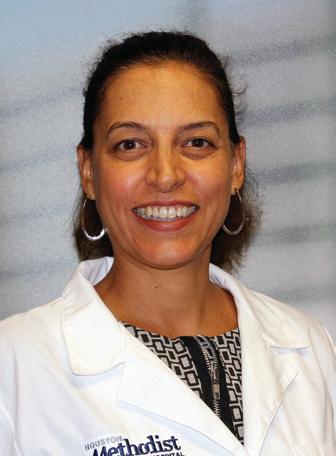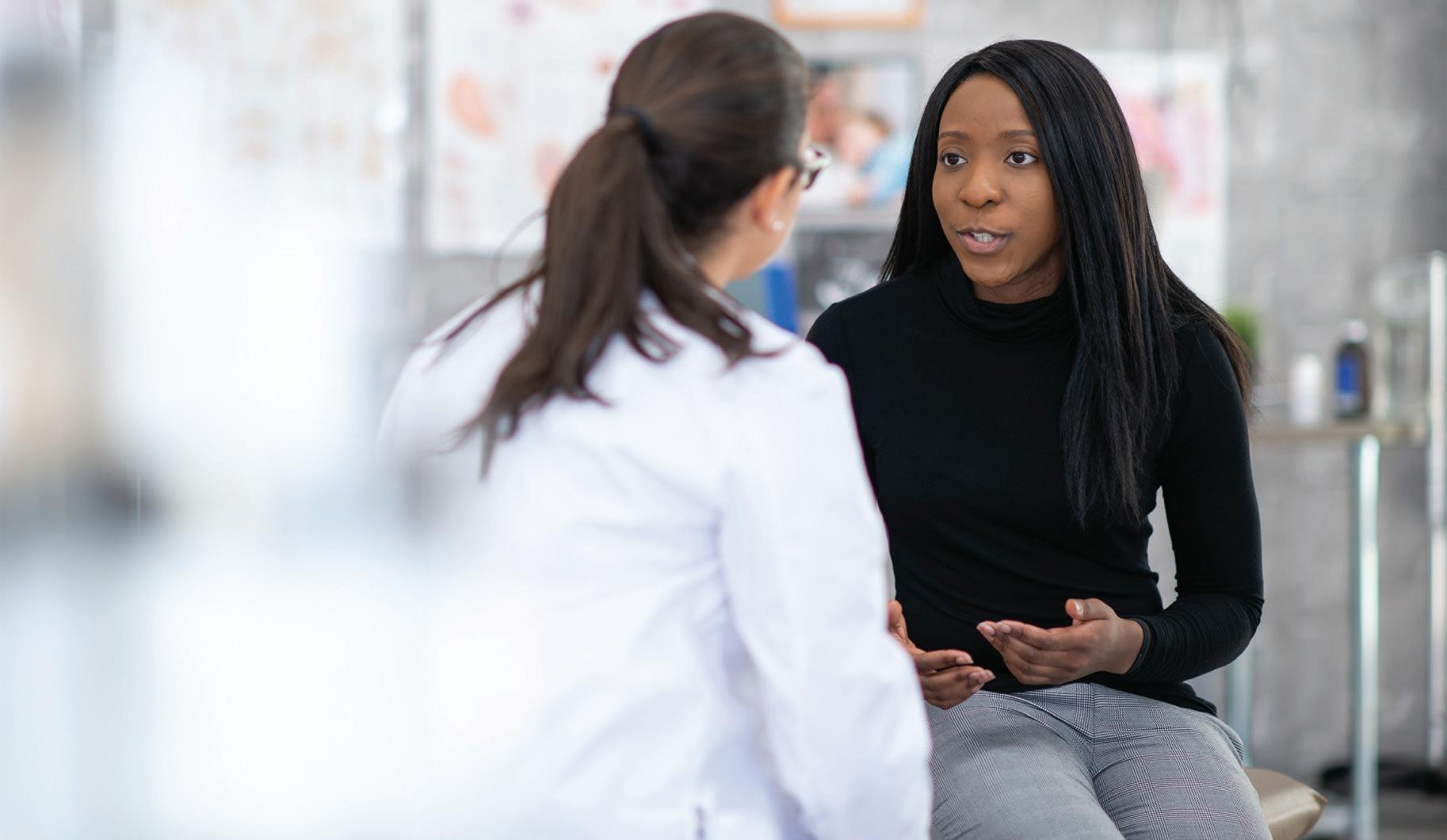LEADING MEDICINE
Know the Signs of a Concussion

Know the Signs of a Concussion
Learn How to Reduce Your Risk
Get More from a Fitness Tracker

5
Learn how stress, worry and anxiety can impact your digestive system.
1 0 11
Discover the signs and symptoms of uterine fibroids and when to seek advice from your gynecologist.

Get to know common back pain conditions and options to gain movement back into your life.

Houston Methodist Orthopedics & Sports Medicine at Baytown will offer convenient Saturday sports injury clinics this fall. All student-athletes at any level can get back in the game faster with doctor evaluations and X-rays or other imaging services.
When:
Saturdays, Aug. 19 – Nov. 4, 8-10 a.m.
Where:
Houston Methodist Baytown Hospital Outpatient Center 1677 W. Baker Rd., Baytown
Please bring your school medical form from your athletic trainer or coach and all applicable insurance information.
Turning 40 means scheduling your first mammogram. You may know what a mammogram is and how important they are, but that first one can be intimidating. Here’s some insight from an expert, Dr. Ana Benveniste, a breast imaging radiologist with Houston Methodist Breast Care Center at Baytown.

1 IT IS NOT AS UNPLEASANT AS YOU MAY IMAGINE.
“There’s definitely pressure and possibly some discomfort during a mammogram,” said Benveniste, “but the process is usually not painful and very fast.”
2 IT WON’T TAKE VERY LONG.
The whole mammogram process is quick and easy, sometimes lasting only five minutes. After removing your top and bra, a technologist positions one breast on the specialized X-ray machine. Next, the machine compresses the breast for a few seconds while the technologist takes an X-ray. This process is repeated two or three times for each breast.
3 YOUR TECHNOLOGIST WILL WALK YOU THROUGH EACH STEP.
Mammogram technologists are always female and completely professional. She clearly explains the process as she does it, all while maintaining just enough casual conversation and keeping you stress-free.

4 YOU MAY GET CALLED BACK FOR MORE IMAGING.
“No one wants to get that call,” offered
Benveniste, “but sometimes the breast imaging isn’t perfectly clear. Do not panic or assume the worst because the call back is often precautionary.”
5
DO YOUR HOMEWORK WHEN PICKING A FACILITY.
The mammogram process itself may look the same, whether in a general imaging facility or one specializing in breast imaging. Many breast imaging facilities seem more spa-like with a calm atmosphere and décor. But do make sure your mammogram is done in a breast-dedicated facility with up-to-date technology and read by a specially trained breast radiologist, an expert in diagnosing tumors. If necessary, the radiologist will guide you to the most appropriate treatment options.
6 ASK FOR A 2D OR 3D MAMMOGRAM.
“With recent technological advances, a 3D mammogram provides a clearer picture of the breast,” stated Benveniste. “This reduces the possibility of being called back for follow-up imaging and improves the chance of catching breast cancer as early as possible.”
7 STICK WITH YOUR IMAGING FACILITY.
Staying with one imaging facility is convenient and ensures your doctor has easy access to past mammograms when looking for any changes. It decreases the chance you are called back for extra images and allows for seamless communication between your doctor and the radiologist. You can request past images be sent to another doctor’s office, but it’s easier to research and find a specialized breast imaging center that you’ll stick with.
Lastly, remember that it is much easier to treat breast cancer when it’s caught early. Getting yearly mammograms is the best way to provide doctors with the information they need, ensuring your peace of mind. •
A recent addition to Houston Methodist Baytown Hospital is contrastenhanced mammography. “This technology is used to determine the extent of cancer in newly diagnosed patients and monitor those undergoing treatment,” said Benveniste. “It can also help screen women who are at a high lifetime risk for developing breast cancer.”
You do not need a doctor’s referral to get a yearly mammogram screening. To schedule, please visit houstonmethodist.org/ breast-care or call
346.292.7465 .

We know by now that a concussion is much more serious than simply “having your bell rung.”
“Young athletes account for a significant number of those who suffer brain injuries,” said Dr. Aaron Tracy, a primary care sports medicine specialist at Houston Methodist Orthopedics & Sports Medicine at Baytown. “Parents need to learn and look for the most frequent signs of concussion.”
“Up to 40% of my patients are children ages 16 and younger,” stated Tracy, “and the majority of those are student-athletes who have suffered a blow or jolt to the head while playing soccer or football.”
The most common concussion symptoms include
■ Balance or coordination issues
■ Dizziness
■ Fatigue
■ Headache
■ Nausea
Lesser-known signs are also important to watch for, including:
■ Difficulty concentrating
■ Memory problems
“You may notice a behavioral change in your child, or emotional issues, like sadness or irritability,” said Tracy. “They may forget where they put their homework or even forget what their name is.”
Tracy advised asking “orientation questions” if you suspect your child may have suffered a concussion during sports practice or another competition.
■ What’s your name?
■ What month and year is it?
■ Do you remember what happened just before your injury?
■ How do you feel?
“If your child’s answers seem off, it’s imperative to make an appointment immediately with a health care professional
trained in concussion evaluation and management,” explained Tracy.
Depending on what the doctor says, your child may miss school and sports to allow the brain to rest.
The best cure for concussion is prevention, so stress the importance of playing by the rules of their sport. Kids should also wear appropriate equipment and demonstrate good sportsmanship. “Your child should notify the coach, referee or athletic trainer at once if he or she senses any concussion symptoms,” urged Tracy. •
Houston Methodist Orthopedic Injury Clinic at Baytown offers same-day appointments with an orthopedic specialist.

The clinic provides treatment for:
■ Acute orthopedic injuries
■ Injured tendons
■ Sports injuries
■ Minor dislocations
■ Sprains and strains
■ Fractures and broken bones
■ Torn ligaments
Please call 281.427.7400 to schedule an appointment with the appropriate physician for those conditions.
The Houston Methodist Orthopedics & Sports Medicine team is on your side. To schedule an appointment with a sports medicine physician, or an orthopedic specialist, visit houstonmethodist.org/orthopedics or call 281.427.7400
Stress, worry and anxiety can have an impact on your digestive system. Do you remember how you felt the last time you had to deliver a speech, got stopped for speeding or went on a job interview?
Those butterflies in your stomach were difficult to ignore. Expressions like “nervous stomach” and “gut feeling” are also indicative of the impact of emotions on the digestive system.
“The collection of neurons in the gastrointestinal tract is the enteric nervous system,” said Dr. Samir Nath, a gastroenterologist at Houston Methodist Baytown Hospital. “This entire system is like your gut’s brain and is very sensitive to moods. Stress can be a big factor in many digestive issues.”

The most common way stress affects the stomach is by worsening the symptoms of a digestive condition you may already have.
Here are three examples:
1. Heartburn
“Heartburn is a burning or pain behind your breastbone,” Nath explained. “It occurs when the muscle between your esophagus and stomach opens up, allowing stomach acid to travel upwards into your esophagus.”
Stress can slow down digestion, keeping food in your stomach longer, which can trigger heartburn.
2. Indigestion
“Any bloating, nausea, belching, gas or diarrhea after eating a meal could be indigestion,” Nath added. Indigestion is most often caused by:
■ Eating too much or too fast
■ Consuming high-fat foods
■ Eating during stressful situations
Indigestion can come and go depending on your stress level.
3. Irritable bowel syndrome (IBS)
IBS is an intestinal disorder that’s often marked by:
■ Cramping
■ Gas
■ Bloating
■ Diarrhea
■ Constipation
Some IBS sufferers find that stress causes flare-ups.
“Stress can’t always be avoided,” Nath stated. “But it can be minimized to help alleviate stomach issues.”
Some key strategies include:
■ Exercise. Regular activity helps reduce stress, control weight, regulate bowel function and improve your overall well-being. Just make sure to exercise before eating or wait at least one hour after a meal.
■ Relaxation and breathing techniques. Yoga, meditation or just taking slow, rhythmic breaths can lessen stress and, in turn, cramps and pain.
■ Biofeedback. This mind-over-matter
technique helps you learn to gain control over certain body functions, including gastrointestinal functions, and bring them back to normal. Biofeedback also helps reduce muscle tension and slow heart rate, promoting a relaxed state.
Almost everyone has occasional stomach issues, but experts say it’s important not to overlook lingering or recurring digestive problems even if you think stress could be the culprit.
If you’ve been experiencing heartburn, indigestion or symptoms of IBS more than two or three times a week, it may be time to see a gastroenterologist. Prolonged digestive problems can be a sign of gastroesophageal reflux disease (GERD), ulcers or other digestive disorders. •

We’ve all been impacted in some shape or form by cancer. It is one of the most prevalent health concerns in the U.S. According to the American Cancer Society, it is estimated that in 2023 alone, there will be over 1.9 million new cancer cases diagnosed in the country. While these numbers are overwhelming, there are ways you and your loved ones can fight back.
The most common cancer types include:
■ Breast
■ Colorectal
■ Lung
■ Prostate
■ Skin
“Early detection is a powerful tool against cancer. Simple changes in our daily lives can make a world of difference in reducing our cancer risk,” said Dr. Ugochukwu Odo, a hematologist-oncologist at Houston Methodist Cancer Center at Baytown.

Between 30-50% of cancers are preventable by eliminating your risk factors and adding a healthy routine.
It’s never too late to get proactive in your health. Reduce your risk with these simple lifestyle changes and promote your overall well-being.
Detecting cancer in its earliest stages increases the chances of successful treatment and improves overall outcomes. It allows for a broader range of treatment options that are often less invasive and more effective. Plus, early detection improves the chances of complete recovery and long-term survival. Regular screenings with your doctor and being attuned to your body’s signals are vital to catching cancer at its earliest stages when it is most treatable.
Not just for your lungs but stop smoking for your overall health.
Fewer drinks per week can lower a woman’s risk for breast cancer.
One of the most important steps you can take is to be familiar with your body’s normal patterns. Odo advises paying attention to any changes or unusual symptoms that continue for an extended period. “When it comes to your health, be the expert of your own body,” Odo said. “No one knows it better than you do. Seek medical attention if something feels off.” Exercise
Add movement by taking the stairs, parking farther away or gardening.
Stay Connected With Your Doctor
Get Regular Screenings
“Your primary care provider (PCP) plays an instrumental role in promoting early detection by collaborating with you to reduce your cancer risk,” Odo said.
Be Your Advocate
Wear Sunscreen
Most health insurance plans cover lung cancer screenings, provided you meet the following criteria:
■ Between the ages 50-77
■ A current smoker or have quit within the last 15 years
■ 20 pack years (multiply the number of packs per day by the number of years smoked)
The screening costs $225 for noninsured or those not wishing to use insurance. Your doctor will need to order the screening.
First Stop: Your Primary Care Provider
Sche
Eat Healthy
Visit Your PCP
Get Screened
Fitness trackers, such as the Apple Watch and Fitbit, are more than just fancy accessories — they can be trusted partners to level up your health journey. By harnessing their capabilities and tracking key metrics or health measurements, you can gain valuable insights and make informed decisions to achieve your health goals. But which fitness tracker metrics really matter when it comes to achieving your goals?
Dr. Eleazar Flores, a board-certified family medicine physician with Houston Methodist Primary Care Group in Mont Belvieu, dives into the most important fitness tracker metrics to track and how they can improve your overall health and fitness goals.


Every step you take counts — the more the merrier. While it may seem like a simple metric, it can be a powerful motivator to get up and move more throughout the day. Research shows that health benefits begin after 7,000 steps. You should aim for a daily step goal of 7,000-11,000 steps.
“Walking is a low-impact exercise that is beneficial for cardiovascular health, weight management and reducing the risk of chronic diseases,” said Flores. “You should hit your goal of at least 7,000 steps every single day.”
Tips to increase your steps:
■ Choose an activity tracker that sends you reminders to get up and move throughout the day. (And actually do it!)
■ Turn a work call into a walking meeting.
■ Go for a walk at the end of your lunch break.
■ Get up to move and stretch when you feel pain or tension while sitting.
■ Park in the back of the parking lot.
■ Take the stairs.
Another important metric to track is active minutes. This metric measures the amount of time you spend engaging in moderate to vigorous physical activity, such as running, cycling or strength training. Exercise is considered moderate when you get your heart rate to about 60-70% of your heart rate max.
The recommended amount is 150 minutes a week, regardless of how you get it — 75 minutes two days a week or 10 minutes three times a day for five days. The cumulative effect leads to a decrease in the risk of mortality, cardiovascular disease and various health conditions.
Flores highlights the importance of finding activities you enjoy. “Engaging in physical activity shouldn’t feel like a chore,” said Flores. “Experiment with different activities until you discover what brings you joy. The key is to get your heart pumping and your body moving.”
Your heart rate is a window into your body’s response to physical activity, providing valuable insights into the intensity of your workouts and the effectiveness of your training. Your heart rate is a measure of how many times your heart beats per minute (bpm). A higher heart rate during exercise generally indicates a higher level of intensity and calorie burn, while a lower heart rate may indicate that you need to increase the intensity of your workouts to see results.
Regularly tracking your heart rate during cardiovascular exercises, such as running or cycling, allows you to monitor your progress over time. As you become more in shape, your heart becomes more efficient at pumping blood, resulting in a lower resting heart rate and a faster recovery rate after exercise.
Flores recommends incorporating high-intensity interval training (HIIT) into your routine to challenge your heart and increase your fitness level.
Your fitness tracker can help unlock the mysteries of your sleep patterns. It will track your movement and your heart rate to determine what sleep cycles you are in. You should aim for seven to eight hours of quality sleep each night.

“Create healthy sleep habits like creating a sleep routine, establishing a relaxing environment and limiting electronic devices before bed,” Flores emphasized. “Paying attention to your
sleep can enhance your overall well-being and support your fitness efforts.”
Stress can have a significant impact on our health and well-being. While fitness trackers may not directly measure stress levels, they use various indicators to provide insights into your stress response, such as your heart rate variability and resting heart rate. This metric can help you become more aware of how stress impacts your body and the techniques to incorporate into your daily route, such as meditation or deep breathing exercises, to help reduce it.
Flores stresses the importance of setting realistic goals. “Start with small, achievable goals and gradually build upon them. This approach helps you maintain motivation and prevent burnout. Celebrate your progress along the way.” •
To speak to a primary care physician about the other important numbers to track to keep you healthy, visit houstonmethodist.org/pcg/east or call 713.441.7965
Uterine fibroids are noncancerous growths that develop on the walls of the uterus, typically occurring during a woman’s premenopausal years. One study found that 70% of white women and 80% of African American women develop fibroids by the time they reach age 50.
If you think you may have uterine fibroids, here’s what you should know about symptoms and treatment.
“Most fibroids cause no significant symptoms,” said Dr. Paul Redman, an obstetrician-gynecologist at Houston Methodist Baytown Hospital. “However, some women may experience excessive pain and heavy bleeding due to the size and location of the fibroid.”

Common symptoms of fibroids include:
■ Back or leg pain
■ Bleeding between periods
■ Constipation
■ Difficulty becoming pregnant
■ Difficulty emptying your bladder
■ Frequent urination
■ Heavy menstrual bleeding
■ Menstrual periods lasting more than a week
■ Pelvic pressure or pain
■ Pain during intercourse
■ Swollen or bloated abdomen
In some cases, fibroids can result in premature labor and miscarriage. Once a fibroid is detected, often during a routine pelvic exam, you may need additional tests, such as a pelvic MRI or an ultrasound.
Doctors don’t know exactly what causes fibroid tumors, but hormones and genetics can make you more likely to develop them.
According to Redman, risk factors for developing fibroids include:
■ Being African American
■ Early onset menstruation
■ Having a family history of fibroids
■ High blood pressure
■ Obesity
If your symptoms are mild, your doctor may suggest a wait-and-see approach, as fibroids grow slowly — or not at all — and tend to shrink after menopause.
“We will first treat mild to moderate symptoms with medication,” explained Redman. “That may mean nonsteroidal anti-inflammatory drugs, antifibrinolytics or hormonal therapies.”
Other treatment options include:
Uterine fibroid embolization (UFE). This minimally invasive procedure is performed by an interventional radiologist who injects small particles into the arteries supplying the uterus. These particles cut off blood flow to fibroids and cause them to shrink and die.
Myomectomy. During a minimally invasive myomectomy, a surgeon inserts thin instruments through small incisions in your abdomen. With robotic myomectomy, a tiny camera attached to an instrument gives your surgeon a 3D view of your uterus, offering greater precision and flexibility than other techniques. Hysteroscopic myomectomy involves the removal of the fibroids through the cervix without an incision.
Hysterectomy. This major surgery involves the removal of the uterus. While a hysterectomy is the only proven permanent solution for fibroids, it ends your ability to bear children.
“A hysterectomy was a common procedure for fibroids 20 years ago,” stated Redman, “but with advances in technology, many patients are happy with the minimally invasive treatments.”
If you think you may be suffering from uterine fibroids, talk with your doctor about the many options available to ease your pain and symptoms. •
If you think you have uterine fibroids, our gynecology specialists are here to help. To schedule an appointment with a gynecologist, visit houstonmethodist.org/gynecology or call 281.420.5760

Every day, millions of people experience discomfort and pain radiating from their spine. However, all back pain is not created equal. Understanding the root cause can often mean the difference between experiencing lifelong discomfort or finding lasting relief.
The spine plays a crucial role in supporting our bodies. It can be a source of various problems. From arm and leg pain to severe conditions requiring surgery, back pain can create serious limitations in our lives. So, when is it time to consider spine surgery?
Dr. Comron Saifi, a spine surgeon at Houston Methodist Baytown Hospital, explores the underlying causes of these conditions.


Spinal stenosis occurs when the spaces within your spine narrow, putting pressure on the nerves leading to the arms and legs. “This can result in pain, numbness, or weakness in your arms or legs. It can make simple activities like walking difficult,” explained Saifi.
Cervical myelopathy is another condition that often originates from cervical spine stenosis. It is characterized by the narrowing of the spinal canal in the neck region, leading to symptoms, such as clumsiness in the hands, balance issues, and numbness in the hands or arms. Saifi describes it as “a silent thief of mobility, often unnoticed until significant symptoms start to show.”
Spinal deformity can lead to chronic back pain due to the abnormal alignment or curvature of the spine. “When the spine's natural curve is disrupted, it can lead to ongoing pain and discomfort,” said Saifi.
Spondylolisthesis is a condition where one vertebral bone slides forward over the bone below it. It can cause both lower back pain and leg pain. “With spondylolisthesis, even simple
movements can be a struggle,” Saifi noted. “It's vital to seek professional advice if you suspect this condition.”
The decision to go ahead with surgery should not be taken lightly, according to Saifi. “Surgery is a viable option when the pain significantly affects the quality of life, conservative treatments have not provided relief, or when there’s nerve damage or progressive neurological decline,” he said.
Pain is not just a symptom. Pain is a signal that your body needs attention. If you’re experiencing persistent or severe back, arm or leg pain, don't disregard it. “Consult a spine specialist to gain a comprehensive understanding of your situation and explore the best nonoperative or operative treatment options available to you,” Saifi advised. •
Early Detection Starts With Your









Early Detection Starts With Your ANNUAL
The recommended age to start your annual mammogram is 40. Schedule yours today.











At Houston Methodist Breast Care Centers, our board-certified experts use the latest imaging technology to provide you with cutting-edge breast screenings — such as 3D mammograms — to detect even the smallest lumps and abnormalities with accuracy. We offer:

• 10+ convenient locations across Houston
• Online scheduling with readily available appointments





• Expanded hours available at most locations
• Access to medical records and test results through MyChart


